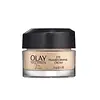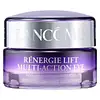What's inside
What's inside
 Key Ingredients
Key Ingredients

 Benefits
Benefits

 Concerns
Concerns

 Ingredients Side-by-side
Ingredients Side-by-side

Water
Skin ConditioningGlycerin
HumectantPetrolatum
EmollientIsopropyl Isostearate
EmollientIsohexadecane
EmollientNiacinamide
SmoothingStearyl Alcohol
EmollientDimethicone
EmollientCetyl Alcohol
EmollientPanthenol
Skin ConditioningTocopheryl Acetate
AntioxidantSodium Ascorbyl Phosphate
AntioxidantRetinyl Propionate
Skin ConditioningCamellia Sinensis Leaf Extract
AntimicrobialBHT
AntioxidantCucumis Sativus Fruit Extract
EmollientC13-14 Isoparaffin
EmollientCaprylyl Glycol
EmollientDimethiconol
EmollientCetearyl Glucoside
EmulsifyingCetearyl Alcohol
EmollientLaureth-7
EmulsifyingStearic Acid
CleansingPalmitic Acid
EmollientBehenyl Alcohol
EmollientDisodium EDTA
Polyacrylamide
PEG-100 Stearate
Titanium Dioxide
Cosmetic ColorantMica
Cosmetic Colorant1,2-Hexanediol
Skin ConditioningSilica
AbrasivePhenoxyethanol
PreservativeIron Oxides
Water, Glycerin, Petrolatum, Isopropyl Isostearate, Isohexadecane, Niacinamide, Stearyl Alcohol, Dimethicone, Cetyl Alcohol, Panthenol, Tocopheryl Acetate, Sodium Ascorbyl Phosphate, Retinyl Propionate, Camellia Sinensis Leaf Extract, BHT, Cucumis Sativus Fruit Extract, C13-14 Isoparaffin, Caprylyl Glycol, Dimethiconol, Cetearyl Glucoside, Cetearyl Alcohol, Laureth-7, Stearic Acid, Palmitic Acid, Behenyl Alcohol, Disodium EDTA, Polyacrylamide, PEG-100 Stearate, Titanium Dioxide, Mica, 1,2-Hexanediol, Silica, Phenoxyethanol, Iron Oxides
Water
Skin ConditioningTheobroma Cacao Seed Butter
EmollientDimethicone
EmollientGlycerin
HumectantIsohexadecane
EmollientPropanediol
SolventAlcohol Denat.
AntimicrobialGlyceryl Stearate
EmollientPEG-20 Stearate
EmulsifyingPEG/PPG/Polybutylene Glycol-8/5/3 Glycerin
HumectantStearic Acid
CleansingPEG-100 Stearate
Palmitic Acid
EmollientOctyldodecanol
EmollientCI 77891
Cosmetic ColorantCI 17200
Cosmetic ColorantC13-14 Isoparaffin
EmollientGuanosine
Skin ConditioningMica
Cosmetic ColorantSecale Cereale Seed Extract
AbrasiveSodium Acetylated Hyaluronate
HumectantHydrolyzed Soy Protein
HumectantHydrolyzed Linseed Extract
Skin ConditioningSodium Hydroxide
BufferingSodium Benzoate
MaskingPhenoxyethanol
PreservativeAdenosine
Skin ConditioningAcetyl Tetrapeptide-9
Skin ConditioningCaffeine
Skin ConditioningTrisodium Ethylenediamine Disuccinate
Polyacrylamide
Dimethiconol
EmollientLimonene
PerfumingPentylene Glycol
Skin ConditioningPentaerythrityl Tetra-Di-T-Butyl Hydroxyhydrocinnamate
AntioxidantTin Oxide
AbrasiveBenzyl Alcohol
PerfumingCaprylyl Glycol
EmollientCapryloyl Salicylic Acid
ExfoliatingMyristic Acid
CleansingGeraniol
PerfumingLaureth-7
EmulsifyingParfum
MaskingWater, Theobroma Cacao Seed Butter, Dimethicone, Glycerin, Isohexadecane, Propanediol, Alcohol Denat., Glyceryl Stearate, PEG-20 Stearate, PEG/PPG/Polybutylene Glycol-8/5/3 Glycerin, Stearic Acid, PEG-100 Stearate, Palmitic Acid, Octyldodecanol, CI 77891, CI 17200, C13-14 Isoparaffin, Guanosine, Mica, Secale Cereale Seed Extract, Sodium Acetylated Hyaluronate, Hydrolyzed Soy Protein, Hydrolyzed Linseed Extract, Sodium Hydroxide, Sodium Benzoate, Phenoxyethanol, Adenosine, Acetyl Tetrapeptide-9, Caffeine, Trisodium Ethylenediamine Disuccinate, Polyacrylamide, Dimethiconol, Limonene, Pentylene Glycol, Pentaerythrityl Tetra-Di-T-Butyl Hydroxyhydrocinnamate, Tin Oxide, Benzyl Alcohol, Caprylyl Glycol, Capryloyl Salicylic Acid, Myristic Acid, Geraniol, Laureth-7, Parfum
Ingredients Explained
These ingredients are found in both products.
Ingredients higher up in an ingredient list are typically present in a larger amount.
This ingredient is also known as "C13-14 Isoalkane".
C13-14 Isoparaffin is created from petroleum-based mineral oils. It is an emollient and helps thicken a product.
As an emollient, it helps keep the skin soft and smooth by creating a barrier on top. This barrier traps moisture in, keeping the skin hydrated.
C13-14 Isoparaffin may not be fungal-acne safe.
Learn more about C13-14 IsoparaffinCaprylyl Glycol is a humectant and emollient, meaning it attracts and preserves moisture.
It is a common ingredient in many products, especially those designed to hydrate skin. The primary benefits are retaining moisture, skin softening, and promoting a healthy skin barrier.
Though Caprylyl Glycol is an alcohol derived from fatty acids, it is not the kind that can dry out skin.
This ingredient is also used as a preservative to extend the life of products. It has slight antimicrobial properties.
Learn more about Caprylyl GlycolDimethicone is a type of synthetic silicone created from natural materials such as quartz.
What it does:
Dimethicone comes in different viscosities:
Depending on the viscosity, dimethicone has different properties.
Ingredients lists don't always show which type is used, so we recommend reaching out to the brand if you have questions about the viscosity.
This ingredient is unlikely to cause irritation because it does not get absorbed into skin. However, people with silicone allergies should be careful about using this ingredient.
Note: Dimethicone may contribute to pilling. This is because it is not oil or water soluble, so pilling may occur when layered with products. When mixed with heavy oils in a formula, the outcome is also quite greasy.
Learn more about DimethiconeDimethiconol is a silicone that resembles the popular dimethicone. Like other silicones, it is an emollient. Emollients create a thin film on skin to prevent moisture from escaping.
This ingredient helps to create a silky texture and improve spreadability. Due to its high molecular weight and thickness, it is often combined with cyclopentasiloxane.
Glycerin is already naturally found in your skin. It helps moisturize and protect your skin.
A study from 2016 found glycerin to be more effective as a humectant than AHAs and hyaluronic acid.
As a humectant, it helps the skin stay hydrated by pulling moisture to your skin. The low molecular weight of glycerin allows it to pull moisture into the deeper layers of your skin.
Hydrated skin improves your skin barrier; Your skin barrier helps protect against irritants and bacteria.
Glycerin has also been found to have antimicrobial and antiviral properties. Due to these properties, glycerin is often used in wound and burn treatments.
In cosmetics, glycerin is usually derived from plants such as soybean or palm. However, it can also be sourced from animals, such as tallow or animal fat.
This ingredient is organic, colorless, odorless, and non-toxic.
Glycerin is the name for this ingredient in American English. British English uses Glycerol/Glycerine.
Learn more about GlycerinIsohexadecane is added to enhance texture, emulsify, and to help cleanse. It is an isoparrafin. It is a component of petrolatum.
Due to its large size, Isohexadecane is not absorbed by the skin. Instead, it sits on top and acts as an emollient. Emollients help keep your skin soft and smooth by trapping moisture within.
Isohexadecane is often used in products designed to help oily skin. It is lightweight and non-greasy while helping to moisturize. When mixed with silicones, it gives a product a silky feel.
Learn more about IsohexadecaneLaureth-7 is created by the ethoxylation of lauryl alcohol using ethylene oxide. Lauryl alcohol is a fatty alcohol with hydrating properties.
This ingredient is an emulsifier and cleansing ingredient. As an emulsifier, it is used to prevent ingredients from separating. It also helps cleanse the skin by gathering dirt, oil, and pollutants to be rinsed away.
Mica is a naturally occurring mineral used to add shimmer and color in cosmetics. It can also help improve the texture of a product or give it an opaque, white/silver color.
Serecite is the name for very fine but ragged grains of mica.
This ingredient is often coated with metal oxides like titanium dioxide. Trace amounts of heavy metals may be found in mica, but these metals are not harmful in our personal products.
Mica has been used since prehistoric times throughout the world. Ancient Egyptian, Indian, Greek, Roman, Aztec, and Chinese civilizations have used mica.
Learn more about MicaPalmitic Acid is a fatty acid naturally found in our skin and in many plant and animal sources. In cosmetics, it is usually derived from palm oil. It serves many purposes in skincare, acting as a cleanser, emollient, and emulsifier.
As an emollient, palmitic acid helps soften and smooth the skin by preventing water loss. In cleansers, it helps remove oil and dirt while creating foam.
Its emulsifying properties help stabilize products by keeping water and oil-based ingredients from separating.
This may not be suitable for fungal acne-prone skin, as fatty acids like this can sometimes trigger breakouts in sensitive individuals.
Learn more about Palmitic AcidPeg-100 Stearate is an emollient and emulsifier. As an emollient, it helps keep skin soft by trapping moisture in. On the other hand, emulsifiers help prevent oil and water from separating in a product.
PEGS are a hydrophilic polyether compound . There are 100 ethylene oxide monomers in Peg-100 Stearate. Peg-100 Stearate is polyethylene glycol ester of stearic acid.
Phenoxyethanol is a preservative that has germicide, antimicrobial, and aromatic properties. Studies show that phenoxyethanol can prevent microbial growth. By itself, it has a scent that is similar to that of a rose.
It's often used in formulations along with Caprylyl Glycol to preserve the shelf life of products.
Polyacrylamide is a synthetic polymer. It is used to stabilize products and bind ingredients. When hydrated, Polyacrylamide forms a soft gel.
Polyacrylamide is low-toxicity. If source properly, it is deemed safe to use in cosmetics.
It should be noted the precursor to Polyacrylamide is acrylamide. Acrylamide is a carcinogen. Most reputable sources of Polyacrylamide will screen for residual acrylamide to make sure the count is in a safe range. Acrylamide is not able to be absorbed through the skin.
We recommend speaking with a professional if you have concerns.
Learn more about PolyacrylamideStearic Acid is a fatty acid. It is an emollient, emulsifier, and texture enhancer.
As an emollient, stearic acid helps soften skin. It aids the skin's protective barrier by preventing water loss. It also provides a gentle cleansing effect without stripping away natural oils.
Stearic acid may also be used to enhance the texture of products. It can add volume and stabilize ingredients such as water and oil. This can help water and oil ingredients from separating.
Sources of stearic acid include animal or vegetable fats/oils such as coconut or shea. It can be naturally found in butter, cocoa butter, shea butter, vegetable fats, and animal tallow.
This ingredient may not be Malassezia folliculitis, or fungal-acne safe.
Learn more about Stearic AcidWater. It's the most common cosmetic ingredient of all. You'll usually see it at the top of ingredient lists, meaning that it makes up the largest part of the product.
So why is it so popular? Water most often acts as a solvent - this means that it helps dissolve other ingredients into the formulation.
You'll also recognize water as that liquid we all need to stay alive. If you see this, drink a glass of water. Stay hydrated!
Learn more about Water